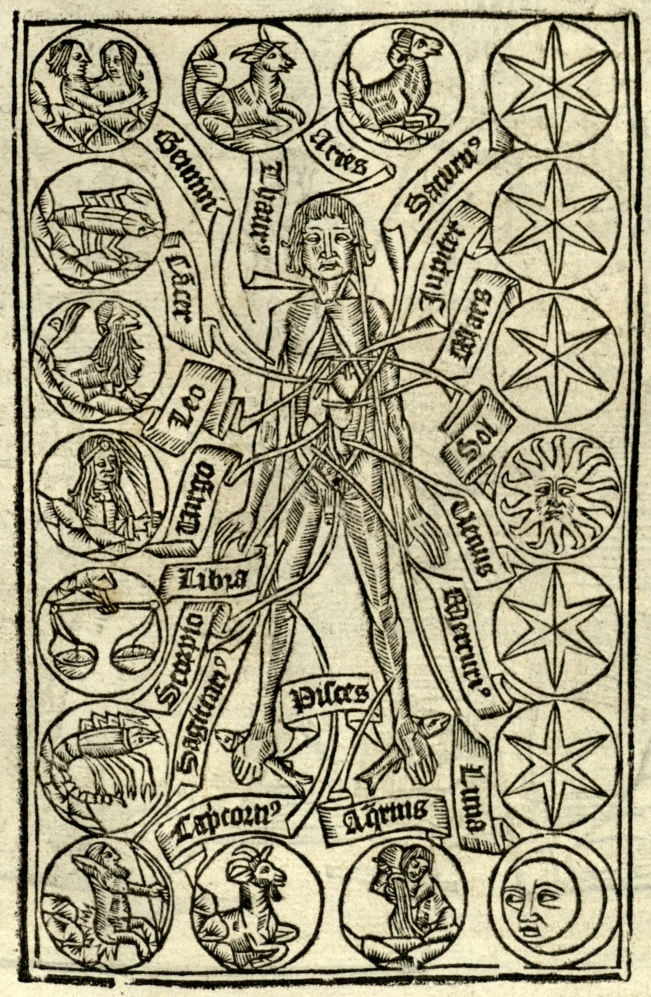– by Elijah Emerson Buchanan Doss, Visitor Services/Gallery Associate
Before influencing the West and prior to the beginning of the Scientific Revolution during the 16th century that changed modern medicine as we currently know it, Vedic texts described the relation between the movement of planetary systems and the human body centuries prior. Astrology and science were never separate entities until recently, but rather the two worked alongside of one another to explain illnesses and to treat sick patients.
According to the Vedas (the oldest scripture of Hinduism), Ayurveda, meaning, “the science of life”, is a system of medicine that is based on the highly evolved astrological system known as Vedic astrology.
Vedic astrology is a system built on the belief that the human mind and body are connected to the movement of planets and stars. We are not disconnected from the universe, but rather incredibly impacted by all its movements and placements. In India, medicine and astrology has worked hand-in-hand for thousands of centuries. It is believed that how the stars and planets are aligned when a person is born indicate how the mind, body and soul will interact with the world around it. Knowing the horoscope of the patient allowed for a full assessment of current illnesses in the body and even predicted ones that may come later in life.
It is said that it was Lord Shiva himself who embodied the 12 zodiac signs, thus designating which planet/zodiac sign is related to what part of the human body. According to Hindu scripture, Lord Shiva himself danced a ‘dance of the death’ to destroy a yajna (sacrifice) created by Daksha Prajapati. Sati, Daksha’s daughter, was married to Shiva at the time of the sacrifice. She attended the ritual despite her husband’s concerns and was faced with belittlement and embarrassment. She felt so much heartache from her father’s disapproval towards her marriage that she killed herself by jumping into the sacrificial fire. Shiva, upon hearing this news, became furious and his body began to encompass the 12 zodiac signs. It is here that he outlines which zodiac and planet influences which part of the body;
Mesha, also known as Aries (Mars, which representing his head), Vrisha/Taurus (Venus, representing his mouth), Mithuna/Gemini (Mercury, representing his two upper limbs), Karka/Cancer (the moon, representing his two sides), Simha/Leo (the sun, representing his heart), Kanya/Virgo (Mercury’s second region, representing the digestive system), Tula/Libra (Venus’s second region, representing the umbilical region), Vrischchika/Scorpio (Mars’s second region, representing his generative organ), Dhanu/Sagittarius (Jupiter, representing his two thighs), Makara/Capricorn (Saturn, representing his two knees), Kumbha/Aquarius (Jupiter’s second region, representing his two legs), and Meena/Pisces (Jupiter’s second region, representing his two feet).
This created a map of the body that has allowed medical astrologers to look at the combinations of planetary alignments in a patient’s astrological chart and help narrow down what treatment will be needed for specific parts of the body. Knowing what astrological sign is linked to what part of the body helps with assessment of the illness and then, ultimately, the cure. It should be noted that due to differing zodiac combinations that two people with a similar disease may be treated differently, and that these combinations don’t only help with physical illnesses but mental illnesses as well.

Ayurvedic medicine includes three specific types of treatment: spiritual (daiwavyapashraya), rational (yukitivyapashraya) and psychological (satvaavajaya). So not only would medicine and other conventional treatments be included but also more holistic treatments as well such as therapy from gemstones and other herbal remedies as well.
Modern medicine, particularly in the West, has eradicated any use of astrology in medicine. Hippocrates himself stated that, “A physician without a knowledge of astrology has no right to call himself a physician.” Yet most physicians today in the West don’t know the first thing about the human body’s relationship to the stars and planets. Medical diagnosis can go quite far, but by utilizing the Ayurveda system, treating illnesses could go far beyond the means of what we currently know. Ancient and Indigenous traditions from India have been shoved aside for more modern treatments in the West, when arguably, both could be utilized to create the best results for the patient. The Vedas are one of the oldest texts in the world; even the founder of modern medicine said that its description of the relationship between human body and the galaxies around it should not be forgotten. It is possible that we could benefit from re-learning it and integrating it into our modern practices. Who knows what other cures we may find if we utilized both modern and ancient knowledge!
Sources:
Charak, K S. “Essentials of Medical Astrology.” Google Books, UMA Publications,https://www.google.com/books/edition/Essentials_of_Medical_Astrology/6CyU_J6LeGsC?hl=en&gbpv=0.
Save, Ashwini, et al. “Diagnostic and Treatment Approach in Ayurveda W.s.r. to Vedic Medical Astrology.” ResearchGate, Genesis Journals, www.researchgate.net/profile/Neha-Parmar/publication/282847926_Diagnostic_and_treatment_approach_in_Ayurveda_wsr_to_Vedic_Me dical_Astrology/links/561e28a508aef097132b31ee/Diagnostic-and-treatment-approach-in-Ayurveda- wsr-to-Vedic-Medical-Astrology.pdf .
Tatavarthy, Bhawaan B R V. “INTEGRATED CONCEPT OF MEDICAL ASTROLOGY AND AYURVEDA.” ResearchGate, The Journal of Research and Education in Indian Medicine, www.researchgate.net/profile/Bhawaan-Tatavarthy/publication/283070178_INTEGRATED_CONCEPT_OF_MEDICAL_ASTROLOGY_AND_AYURVED A/links/56287de708aef25a243c6959/INTEGRATED-CONCEPT-OF-MEDICAL-ASTROLOGY-AND- AYURVEDA.pdf.
